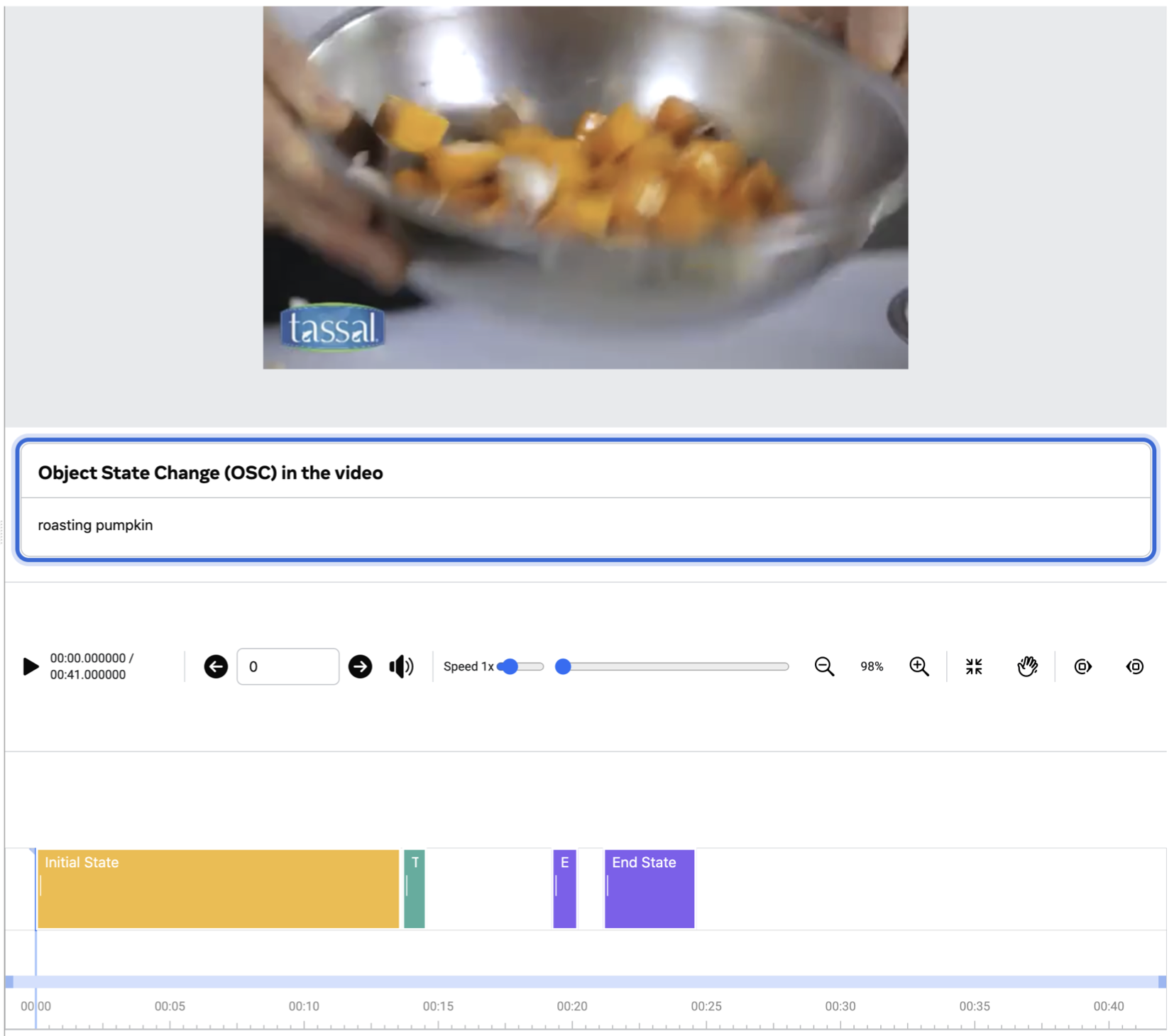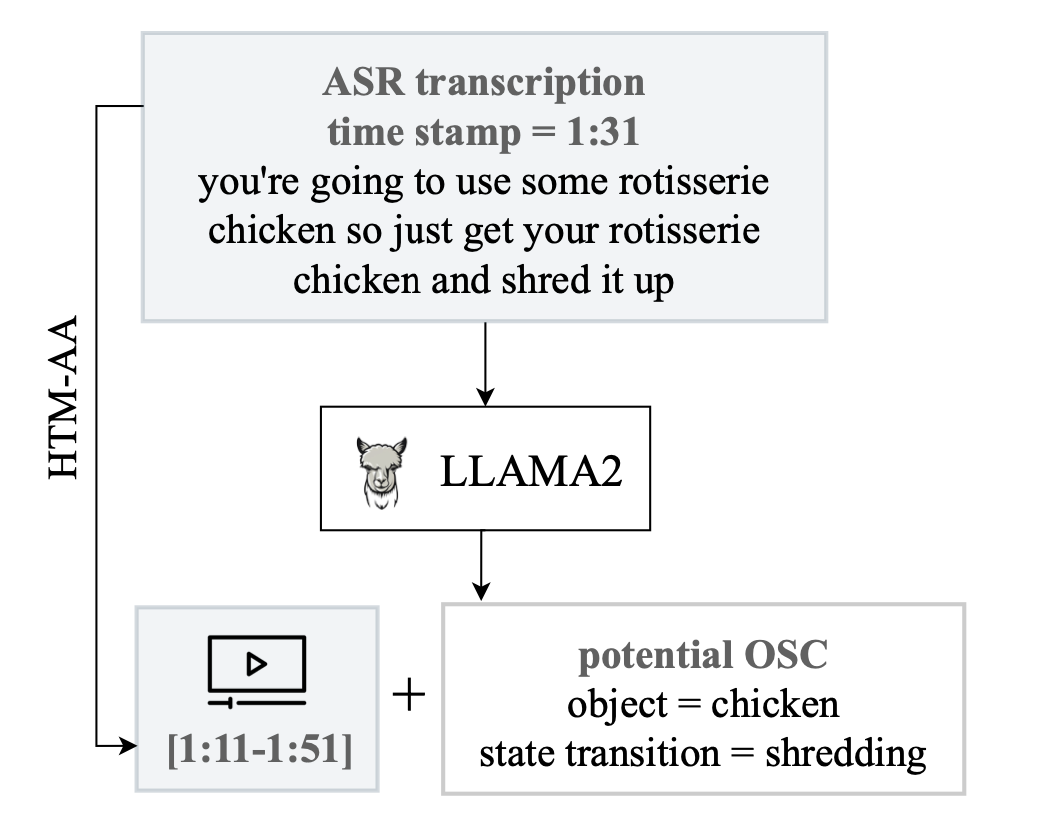Learning Object State Changes in Videos: An Open-World Perspective
Zihui Xue, Kumar Ashutosh, Kristen Grauman
CVPR, 2024
project page | arxiv | bibtex
- 09/24: Added code support for ChangeIt & ChangeIt (open-world)
- 07/24: Provided pre-processed VideoCLIP pseudo labels on HowToChange
HowToChange (Evaluation): we collect temporal annotations for 5,423 video clips sourced from HowTo100M, encompassing 409 OSCs (20 state transitions associated with 134 objects).
HowToChange (Pseudo-labeled Train): we propose an automated data collection process (paper Section 3.3) and identify 36,075 video clips that may contain OSC, using ASR transcriptions and LLAMA2.
- See data_files/osc_split.csv for the complete list of OSCs and seen/novel splits.
- See data_files/howtochange_eval.csv for:
- video clip information (first 4 columns: video name, YouTube id, start time and duration)
- temporal annotations (middle 3 columns: time ranges for the initial, transistioning and end state of OSC)
- OSC associated with the clip (last 2 columns: OSC name and whether this is novel OSC)
- See data_files/howtochange_unlabeled_train.csv for:
- video clip information (first 4 columns: video name, YouTube id, start time and duration)
- OSC associated with the clip (last 2 columns: OSC name and whether this is novel OSC, last column always False since all train OSCs are seen)
-
Clip extraction: run data_scripts/preprocess_clip.py to extract these clips. Make sure to have yt-dlp and ffmpeg installed.
❗️ Please note that the VidOSC code utilizes pre-processed features, which can be found here. This clip extraction step is optional and intended for those interested in visualizing specific video clips. If you require access to the complete HowToChange videos but are experiencing issues with YouTube downloads, please fill the form for a full copy. -
Pseudo label generation: Run data_scripts/pseudo_label.py to pseudo label training clips with CLIP/VideoCLIP. To use VideoCLIP, make sure to have the MMPT toolkit installed.
🆕❗️[Update July 2024]: We provide preprocessed pseudo labels by VideoCLIP here, where -1=ambiguous, 0=background, 1=initial state, 2=transitioning state, 3=end state. -
See data_scripts/read_ann.py for helper functions to extract frames and read the annotations.
- Run data_scripts/evaluator.py, remember to replace
predict()with your model's prediction function. The evaluator is set as 1fps.
- set up the environment
conda env create --file environment.yml
conda activate vidosc- update data path in train.py:
🆕❗️[Update July 2024]: We provide InternVideo (+object-centric) features here. Download them and put the two folders under ./data. feats_handobj currently lacks some training files, but is complete for evaluation purposes.
🆕❗️[Update July 2024]: We provide VideoCLIP pseudo labels here. Download and unzip it to the project folder as ./videoclip_pseudolabel.
--feat_dir (default as ./data): path to InternVideo-MM-L14 features (feats) and object-centric InternVideo-MM-L14 features (feats_handobj).
--pseudolabel_dir (default as ./videoclip_pseudolabel): path to pseudo labels (download the pseudo labels above or run data_scripts/pseudo_label.py to generate pseudo labels).
Data Structure:
data
|- feats
|- feats_handobj
videoclip_pseudolabel
data_files
|- howtochange_unlabeled_train.csv
|- howtochange_eval.csv
|- osc_split.csv
We provide VidOSC checkpoints here. Download and put them under ./checkpoints.
# no object-centric feat, use your trained models
python train.py --det 0 --sc_list $SC_NAME --ckpt ./logs/xxx/xxx.ckpt
# with additional object-centric feat, use provided checkpoints
python train.py --det 1 --sc_list $SC_NAME --ckpt ./checkpoints/$SC_NAME.ckpt
# multi-task evaluation
python train.py --det 0 --sc_list all --ckpt ./checkpoints/multitask.ckpt--ckpt: path to the model checkpoint.
--sc_list: specify the state transition to evaluate.
# Train one model for one state transition
sc_list=("chopping" "slicing" "frying" "peeling" "blending" "roasting" "browning" "grating" "grilling" "crushing" "melting" "squeezing" "sauteing" "shredding" "whipping" "rolling" "mashing" "mincing" "coating" "zesting")
for sc in ${sc_list[@]}; do
python train.py --det 0 --sc_list $sc --log_name $sc
done
# Train one multitask model for all state transitions (see paper Table 7)
python train.py --det 0 --sc_list all --log_name multitask--det: 0: InternVideo features, 1: global InternVideo + object-centric Internvideo features as input (paper Section 3.2).
--sc_list: specify the state transition to train, using all trains a multitask model for all state transitions.
We provide VidOSC checkpoints here. Download and rename the checkpoints folder as ./checkpoints_changeit.
# single-task (replace $CATEGORY with the class name, e.g., apple, avocado, etc.)
python train_changeit.py --category $CATEGORY --ckpt ./checkpoints_changeit/single_task/$CATEGORY/**.ckpt
# multi-task
python train_changeit.py --det 1 --ckpt ./checkpoints_changeit/multi_task/[state_best.ckpt|action_best.ckpt] --use_gt_action --ordering
# open-world
python train_changeit.py --novel_obj --det 1 --ckpt ./checkpoints_changeit/open_world/[state_best.ckpt|action_best.ckpt] --use_gt_action --orderingNote:
- Single-task checkpoints do not adopt object-centric features (i.e.,
det == 0). We conducted hyperparameter search for pseudo label thresholds (state_thre1,state_thre2andaction_thre). You can find the threshold value used in the checkpoint name. --use_gt_actionand--orderingcontrol whether to use ground truth action indices and whether to enforce causal ordering during inference. Turning these on or off can affect performance.- For output torch metrics, refer to
val_avg_prec_1for state precision@1, andval_avg_action_prec_1for action precision@1. For final results, we provide two sets of models: one optimized for the best state metrics and another for the best action metrics, as reflected in the checkpoint names. - In the open-world setting,
{val/test}_avg_prec_1and{val/test}_avg_action_prec_1indicate the precision metrics for known (val) and novel (test) splits.
We provide the necessary files for ChangeIt training here. Save them under ./data_changeit or modify --dataset_root in train_changeit.py as needed. Additionally, place all files from the original ChangeIt repository into this folder as well.
# single-task (set --det to 0 for regular internvideo features or to 1 for additional object-centric features.)
python train_changeit.py --det 0/1 --category $CATEGORY \
--state_thre1 $THRE1 --state_thre2 $THRE1 --action_thre $THRE2 \
--log_name single_task/$CATEGORY
# multi-task
python train_changeit.py --det 1 --use_gt_action --ordering \
--state_thre1 $THRE1 --state_thre2 $THRE1 --action_thre $THRE2 \
--log_name multi_task
# open-world
python train_changeit.py --det 1 --novel_obj --use_gt_action --ordering \
--state_thre1 $THRE1 --state_thre2 $THRE1 --action_thre $THRE2 \
--log_name open_worldSet $THRE1 and $THRE2 based on CLIP probabilities. It's recommended to sweep these values between 0.35 and 0.45 to find the optimal settings.
VidOSC is licensed under the CC-BY-NC license.
If you find our work inspiring or use our codebase in your research, please consider giving a star ⭐ and a citation.
@inproceedings{xue2024learning,
title={Learning object state changes in videos: An open-world perspective},
author={Xue, Zihui and Ashutosh, Kumar and Grauman, Kristen},
booktitle={Proceedings of the IEEE/CVF Conference on Computer Vision and Pattern Recognition},
pages={18493--18503},
year={2024}
}

